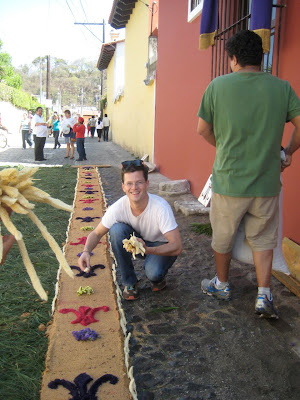On Thursday night, Hug It Forward director Chris Barry came to my project site and we signed a contract, along with community representatives and the mayor. I’m really excited!

Specifically, this meeting dealt with the accountability of all involved parties – from left to right in this photo:
The Community - Don Miguel is a prominent leader in the village
Hug It Forward - that’s NGO Director Chris Barry
Peace Corps - I’m the project coordinator
The Municipality - that’s Doña Miriam, our mayor
(Our newly named)Project Foreman– Frainer
Everyone’s contributions thus far were spelled out and all upcoming responsibilities noted with regards to the construction phase of the next 2-3 months.

What went especially well is that the community got a strong voice in deciding how to manage the project, even though they aren’t providing any of the funding. My hope is that community project direction will result in prouder work and a better final result.

Specifically, I was very happy that the Municipality allowed the community to use local men as their labor source. Originally, our mayor had agreed to pay the wages of two assistant masons for the project, but instead of assigning some of her existing employees to the job, she let the community pick its own workers. Her decision surprised me a bit, seeing that there are plenty of peopleat the Muni who receive a salary but do very little actual work(and you wonder why we have budget “problems” :) ). The bottom line is that I applaud her choice and I think we’ll avoid a whole host of problems as a result.
Here are some labor details you might find interesting:
Project foreman (mason, experienced in concrete building and construction)
- funded by Hug It Forward on a 6,400 quetzal contract of approx. 2 months of work, paid out in 4 biweekly checks, averaging out at around Q125.00 or $17 US daily
Assistant masons
- funded by the Municipality at 5,000 quetzales apiece for the same timeframe, averaging around Q100.00 or $13 US daily)
note: Unskilled labor is provided by the community.
Basically, we’re ready to go. After the massive bottle collection from a couple weeks back, we now have more than 4000 filled bottles (eco-ladrillos), with probably another 4000 partially filled– that’s more than enough to begin construction. All that remains is for the community to level the project site, which, given that they’ll probably do it by hand and the school will measure roughly 42’ by 21’, they’ll need at least a couple weeks. On the far end of the soccer field in this picture is where the school will be built.

In the meantime we’ll be making the funding arrangements…..
To everyone reading this - thanks for your support! Please let me know if you have any questions, or feel free to check out some of my earlier posts here, here, here and here.











